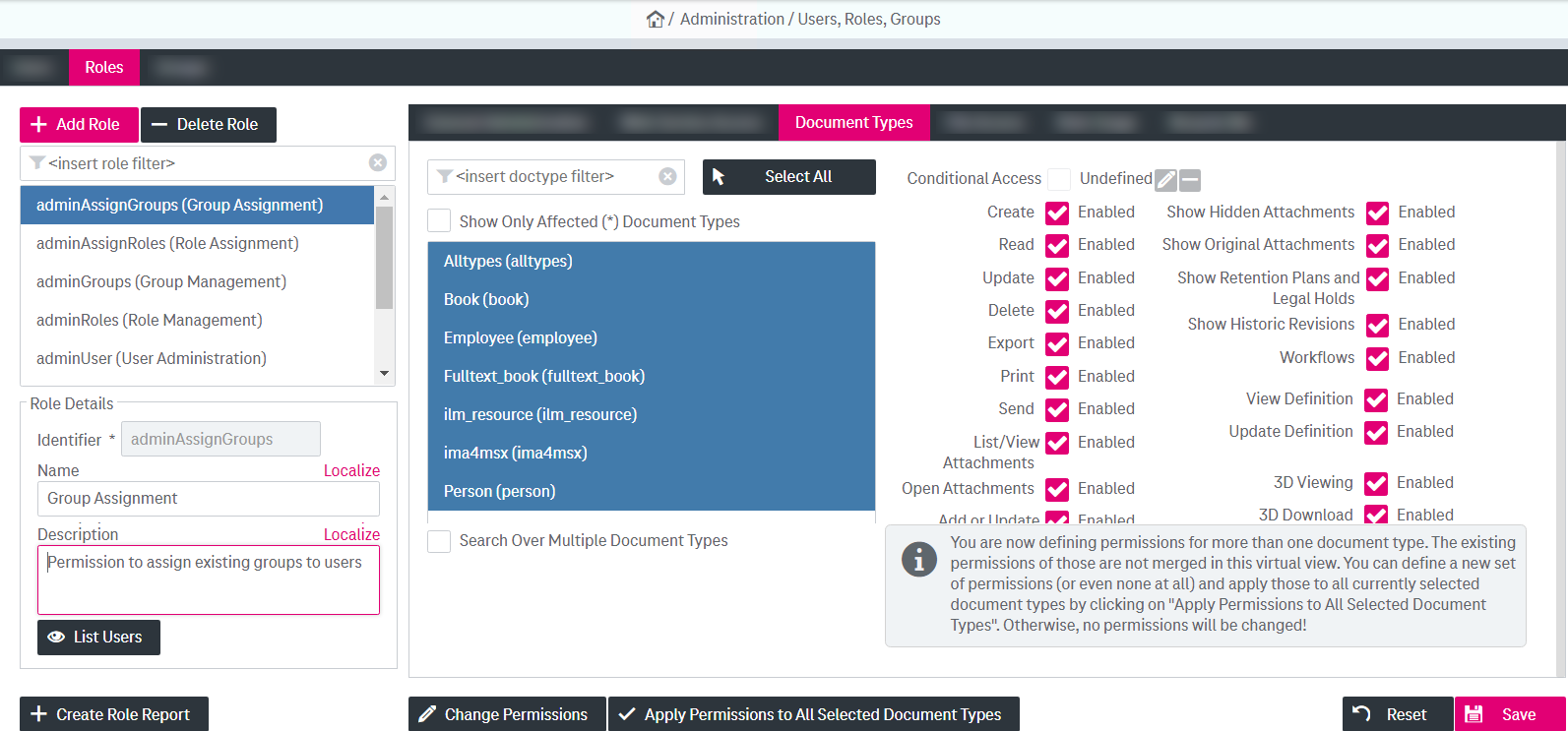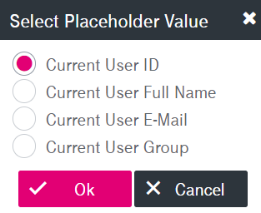Document type administration permissions
This panel contains user permissions for work with ImageMaster documents in the ImageMaster WorkplaceClient as described in [UM WorkplaceClient] and permissions for different operations with a document type, including access to the attributes, that can be performed by the administrator in the Document Types room; see chapter Handling the document structure for more information on this configuration room. With enough permissions the corresponding document type will be available in the relevant list of the Document Types room: either only displayed (read permission enabled) or also editable (update permission enabled).
All available document types are shown in the list. Documents types used by selected role are indicated with an asterisk (*). By choosing a type in the list, you can set the rights for the selected role.

Figure 124: Users, roles, groups – roles: document type administration permissions
To configure permissions for document types:
-
Select a document type in the list, set the required values by selecting the check boxes. Optionally filter the list to display only document types used by selected role by activating the function Show Only Affected (*) Document Types.
See chapter Setting permissions for a role for instructions on how to set permissions.
If no read permission is set to “Enabled”, none of the configuration rooms will be available to the user and therefore the administration view will be unavailable.
If a read permission is set to “Disabled”, the corresponding document type will also be unavailable in user views (see [UM WorkplaceClient]).
-
To change the rights for several document types at once, select document types in the list and click the button Apply Rights to All Document Types, which is only enabled in case of multiple selection. If you change the selection in the list, all current right changes will be unset, even by resetting rights to "undefined" in case of multiple selection or by showing the current rights of a document type for single selection.
-
To assign the “create documents” permission to the role, scroll to the bottom of the list and select the Create Document Types box.
See figure Users, roles, groups – roles: document types permissions.
If the create documents permission is enabled, read access to the full list of document types becomes enabled too, even if read permissions are set to “Undefined”.
To explicitly exclude a document type from the list of the document types accessible by the role, set the read permission for this document type to “Disabled”.
-
To assign the “search over multiple document types” permission to the role, scroll to the bottom of the list and select the Search Over Multiple Document Types box.
See figure Users, roles, groups – roles: document types permissions.
If the permission is enabled, search by attributes in multiple document types at the same time is allowed.
-
The table Roles management – document access permissions: operations below contains the list of operations for which you can specify permissions. If a permission for an operation within a document type is set to “Enabled”, the user with the assigned role can perform the action with all documents of the corresponding document type; for details also see [UM WorkplaceClient].
-
You can create, edit and remove conditions for the enabled access right for each document type. The condition builder allows the visual definition of access to a document type based on certain attribute values. You can create, edit and remove conditions for the enabled access right for each document type. To create a condition:
-
Click Add Condition. The condition builder panel will be displayed:
-
Select an attribute of the specified document type from the list. Hidden attributes are not available.
-
Specify search criteria by choosing a comparison operator and setting your desired values.
The available comparison operators depend on the selected attribute type.
-
Optional:
-
 Select Placeholder
Select PlaceholderClick the icon to specify the placeholder for the attributes. The option is supported for the attribute types "date/ dateTime" and "string". Select the available options in the appeared window and click OK:
-
Negate
Select the box to apply the logical operator "not" to the whole condition. The negated condition effects the opposite truth value.
-
Ignore Case
By default the search is case-sensitive. Select the box to deactivate case-sensitive search.

The specified value will be set as a placeholder for the corresponding attribute.
-
-
Optional: Add further search terms by clicking Add Term:
-
Terms can be connected by Boolean operators “and” (default) as well as “or”, so by default each term connected with “and” further reduces the result set. To change the connection click Swap AND/OR.
-
Connection operators are evaluated in order of appearance.
-
-
To delete the term, click the minus icon nearby.
-
Optional: Click Add Condition to specify additional conditions. Conditions can be connected by Boolean operators “or” (default) as well as “and”, so by default conditions connected by "or" retrieve results that match any condition or all of them. To change the connection click Swap AND/OR.
-
To delete the condition, click the minus icon nearby.

If the selected document type contains no attributes, the condition can not be configured and the functionality is disabled.
-
Click Ok to create condition.
-
-
To edit a created condition:
-
Click the edit condition icon
 . The condition builder dialog will be displayed.
. The condition builder dialog will be displayed. -
Adjust the settings and confirm changes by clicking Ok.
-
|
Operation |
Description |
|---|---|
|
Create |
The user is allowed to create new ImageMaster documents of this type. |
|
Read |
The user is allowed to view the documents’ metadata, i.e. the user can find documents of this type by a search and they are displayed in the hit list. |
|
Update |
The user is allowed to change ImageMaster documents, i.e. to update metadata and to add or remove attached files. |
|
Delete |
The user is allowed to delete all of the document’s underlying versions. After deletion the document may physically remain in the archive, yet it will not be accessible by the user via the Web client. |
|
Export |
The user is allowed to export documents. |
|
|
The user is allowed to print documents. |
|
Send |
The user is allowed to send document links per e-mail. |
|
List/View Attachments |
The user will see the list of the files attached to the document. Moreover, this allows opening the preview of the attachments. |
|
Open Attachments |
The user is allowed to open each of the files attached to the document. This operation covers opening the attachment externally as well, similar to a download. When this permission is enabled, the “List/View Attachments” permission with an “Undefined” value will be enabled. |
|
Add or Update Attachments |
The user is allowed to add a file attachment to a document and to update it. When this permission is enabled, the “List/View Attachments” and “Open Attachments” permissions with “Undefined” values will be enabled. |
|
Show Hidden Attachments |
The user will see hidden document attachments. |
|
Show Original Attachments |
The user will see original document attachments. |
|
Show Retention Plans and Legal Holds |
The user is allowed to view Retention Plans and Legal Holds for documents, i.e. the corresponding context menus will be available in the hit list. See chapters Access to retention management and Access to legal holds for scenarios of Retention Plans and Legal Holds configuration and chapter Publications for further related details. |
|
View Definition |
The user is allowed to view definitions. |
|
Update Definition |
The user is allowed to change definitions. |
|
For the 3D options below also see Content Services for 3D Structures.
|
|
|
3D Viewing |
The user is allowed to view 3D documents. |
|
3D Download |
The user is allowed to download 3D documents. |
|
3D Export |
The user is allowed to access 3D exports. |
|
3D Litigation Export |
The user is allowed to access 3D litigation exports. |
|
Table 38: Roles management – document access permissions: operations |
|
